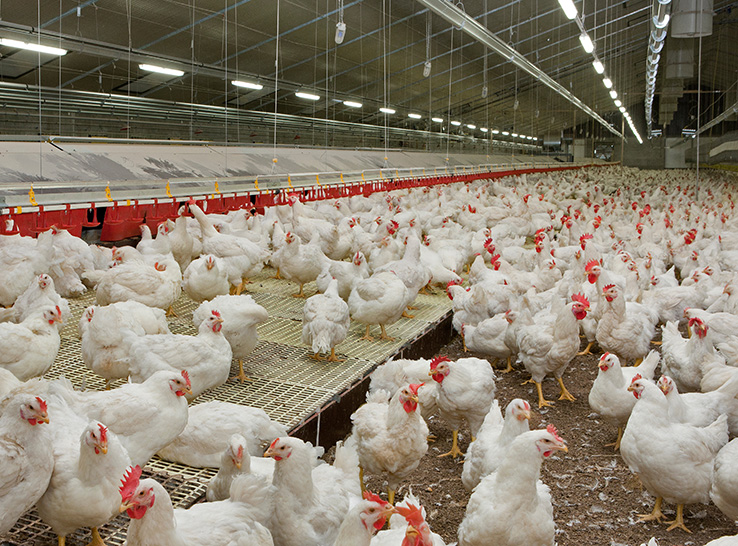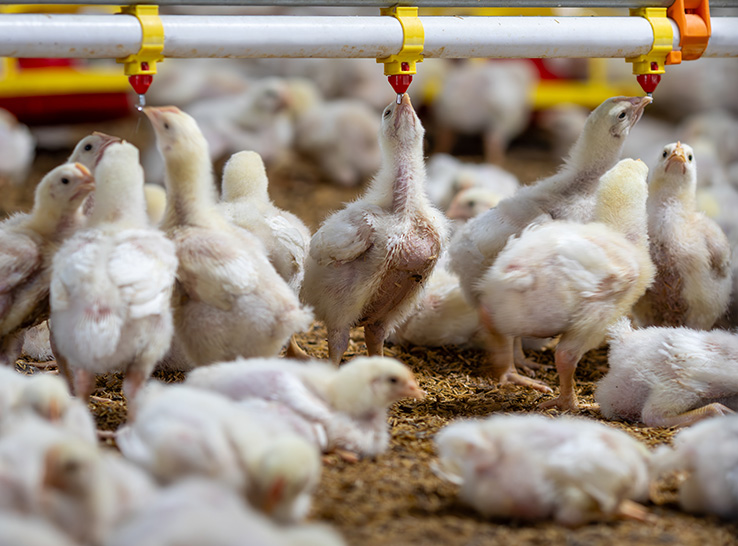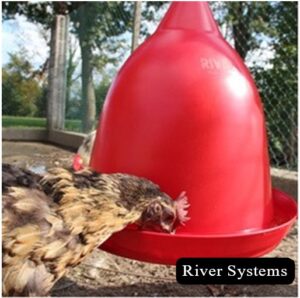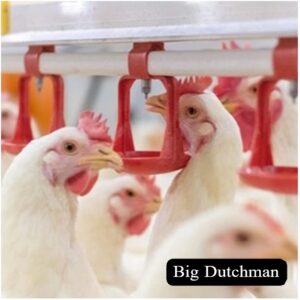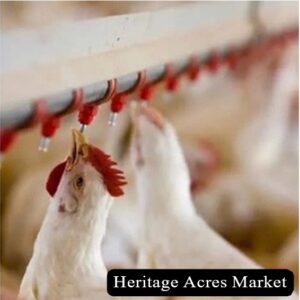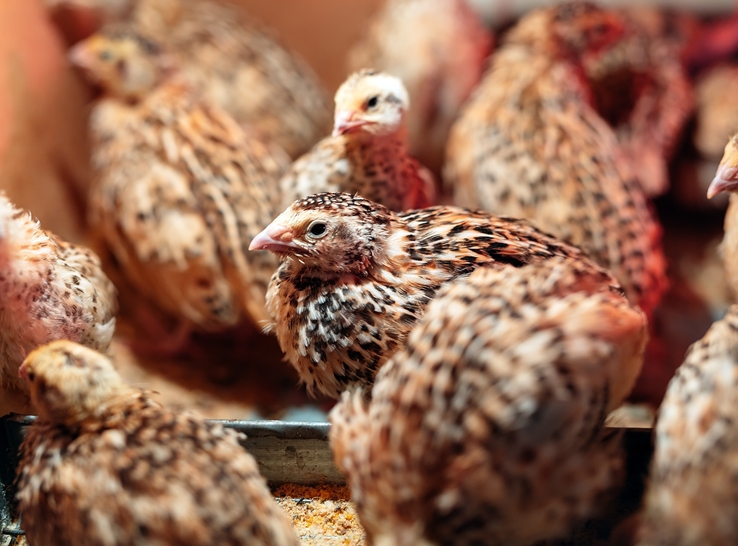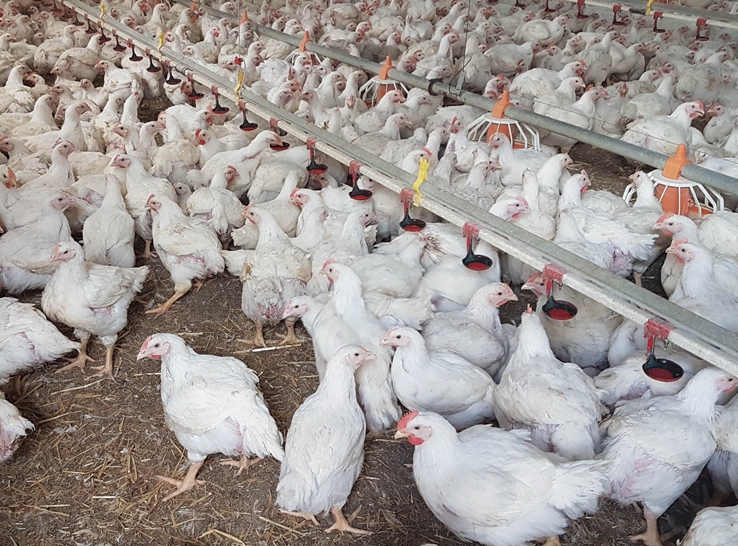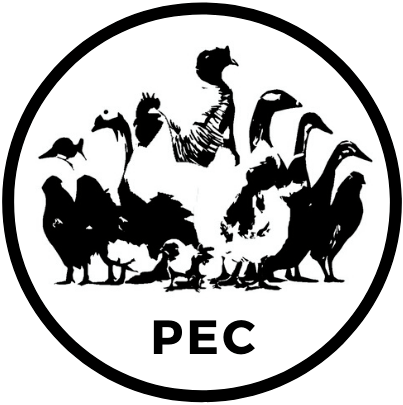By Allison Weaver and Allison Pullin, PhD, North Carolina State University
Drinking behavior in poultry develops within the first couple days of life. When an open water source is provided, birds stick their beak roughly 10 mm into the water, use a scooping motion to collect water in their beak, extend their neck in a vertical position, and use gravity to transport water down their esophagus to their crop. While this sequence is the natural drinking behavior for birds, they can adjust their movement patterns to accommodate for different drinker types. Water consumption is often used as an indicator of overall flock health, as changes in drinking behavior can be a sign of illness or other management issues. The following factors can affect drinking behavior:
Types of drinkers
There are three different types of drinkers commonly used in the poultry industry: bell/trough drinkers, nipple drinkers without cups, and nipple drinkers with cups. Each style of drinker comes with its own pros and cons.
Bell/trough drinkers
Bell drinkers allow birds to display the natural drinking behavior sequence by scooping water out with their beak, and research shows that chickens prefer this type of drinking system. While birds visit bell drinkers less frequently compared to nipple drinkers, they consume more water during a single visit. However, water spillage from bell drinkers creates bird health and sustainability risks, such as increased water wastage, higher moisture content and caking in litter, and an increased risk for foot pad lesions (i.e. pododermatitis). Water contamination is another health risk with bell drinkers, where the open water can become contaminated dirt and fecal matter, reducing water quality and increasing risk for disease.
Nipple drinkers
With nipple drinkers, birds peck in an upward motion to trigger a pin, allowing water to be released from the nipple and into the bird’s mouth. Consequently, nipple drinkers have a much lower risk of water spillage and contamination compared to bell drinkers, resulting in less litter moisture underneath the drinkers and reducing the risk of pododermatitis. Nipple drinkers with cups further improve litter quality by catching any of the water that does not go into the bird’s mouth. However, because birds are unable to perform the natural drinking behavior sequence as they do with bell drinkers, birds are unable to consume water as quickly and spend more time at the drinker. Risks associated with nipple drinkers include air bubbles blocking water flow, water leaks, and inconsistent drinker height if the floor is not level throughout the house. Water collected in cups underneath nipples can also become contaminated with dirt and fecal matter, creating health risks if birds drink water from cups.
Determining drinker height
rinker height is an important part of drinker management. If birds are unable to reach the drinker or efficiently receive water, dehydration can result. Drinker heights should be adjusted with age.
Bell/trough drinkers: Approximately at the height of the birds’ crops (similar to feeders). Birds need to be able to easily reach their heads and neck over the trough without excess strain or injury. If the bell/trough drinkers are too low, it will be easier for debris to contaminate the water.
Nipple drinkers: Nipple is at the bird’s eye level at chick placement, but then raised to slightly above eye level as the birds age. Birds should have to extend their neck upwards at a slight angle
(~45 degrees) without straining. If drinkers too high, birds cannot reach nipples. If drinkers are too low and birds’ necks are not extended, water can more easily fall through their beaks onto the floor. Decreased water consumption can lead to decreased feed consumption.
Important reminders for nipple drinkers:
- Keep drinker lines level to prevent air bubbles that restrict water flow.
- The end of the drinker line should not be higher than the regulator.
Unlevel drinker lines can also create an issue where drinkers are too high for birds in some spots and too low for birds in other spots, leading to issues with water consumption and wastage.
Monitoring flow rate
In order to ensure birds are getting adequate amounts of water from nipple drinkers, it is important to measure flow rates from individual nipples. Flow rate can be determined by using flow rate meter or a container that measures water in milliliters. Press the measuring device against the nipple and record for 30 seconds. After the 30s, look to see how many milliliters (mL) of water filled the container. Multiply that by two to determine mL/minute. For broilers the appropriate flow rate should be calculated by the equation:
Weeks of age x 7 + 20 [Dozier, 2003]
Example: 4-wk broiler x 7 + 20 = 48 mL/min
Tips for water sanitation
Maintaining clean water is important for the health of the flock. Certain pathogens, like bacteria and fungi, can build up in drinker lines over time, causing the spread of disease. Here are some tips for optimum water sanitation:
- Always use clean, potable drinking water Regularly test water quality
- Develop a sanitation program using approved water sanitizers* (i.e., chlorine, hydrogen peroxide, iodine etc.)
- Regularly flush water lines between flocks and after running anything (medications, sanitizers, etc.) through the water line Monitor for low water pressure, which can indicate the presence of biofilm (accumulation of pathogens) in the water line
- Replace water filters often to reduce build- up
Risks of poor drinker management
Poor drinker management is not only a major welfare concern for birds, but it can also result in decreased production and profitability. Failure to take proper drinker management into consideration can lead to:
- Disease
- Dehydration
- Inefficient drinking behavior
- Decreased feed consumption
- Loss of body weight
- Decreased performance
- Increased flock mortality
References
- Manning, , S. A. Chadd, and R. N. Baines. 2007. Key health and welfare indicators for broiler production. World’s Poultry Science Journal 63:46–62.
- Nicol, C. J. 2015. Behavioural needs, priorities and preferences. Pages 79-103 in The Behavioural Biology of
- Deeb, , and A. Cahaner. 2002. Genotype-by-environment interaction with broiler genotypes differing in growth rate. 3. Growth rate and water consumption of broiler progeny from weight- selected versus nonselected parents under normal and high ambient temperatures. Poultry Science 81:293–301.
- Bruno, , A. Maiorka, M. Macari, R. Furlan, and P. Givisiez. 2011. Water intake behavior of broiler chickens exposed to heat stress and drinking from Bell or and nipple drinkers. Revista Brasileira de Ciência Avícola 13:147–152.
- McCreery, H. 2015. Water consumption behavior in broilers. PhD Diss. Univ. Arkansas.
- Glatz, P., and M. Moore. 2004. Production systems: Poultry. Pages 22-31 in Encyclopedia of Meat W. K. Jensen, ed.
- Fairchild, B. D. 2008. Broiler tip: Considerations in poultry drinker line management. The University of Georgia Cooperative Extension Service Available at https://poultry.caes.uga.edu/content/dam/caes-subsite/poultry/documents/archived- poultry-tips/drinker-line-management-jul 09.pdf (verified 15 May 2024).
- Ziggity Systems, Understand broiler drinking behavior to achieve better flock performance Available at https://ziggity.com/wp-content/uploads/helpfularticles/ cont_article_pdf_14.pdf (verified 21 May 2024).
- Quichimbo, , J. Quintana, D. Rodriguez-Saldana, C. Lopez-Coello, S. Gomez, and F. Castellanos. 2013. Effect of nipple type drinker height on productive parameters of broilers. International Journal of Poultry Science 12:144–147.
- Goan, H. Management of Nipple Watering Systems forBroilers. The University of Tennessee Agricultural Extension Service. Available at https://sumner.tennessee.edu/wp-content/ uploads/sites/48/2020/02/Backyard-Poultry-ManagementNippleWater-pb1533.pdf.
- Dozier, W. A. 2003. Low nipple flow rates: Broiler performance. The University of Georgia Cooperative Extension Service. Available at https://poultry.caes.uga.edu/content/dam/caes- subsite/poultry/documents/archived-poultry-tips/low-nipple-flow-rates-poor-performance- may-03.pdf (verified 16 May 2024).
- Maharjan, 2013. Evaluation of water sanitation options for poultry production. Masters Thesis. Univ. Arkansas.
- Ziggity Systems, Inc. Biofilm: How to prevent and eliminate it. Poultry Watering University. Available at https://poultrywateringu.com/biofilm-how-to-eliminate-and-prevent-it/ (verified 21 May 2024).
To view all issues of Poultry Press, click here.
Editor’s note: Content on Modern Poultry’s Industry Insights pages is provided and/or commissioned by our sponsors, who assume full responsibility for its accuracy and compliance.

